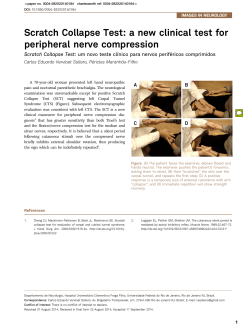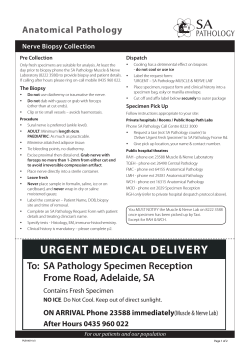
Co-Authors: Stephen Flood Michael Weymouth
Natasha van Zyl MBChB, FRACS Plastic and Reconstructive Surgeon The Upper Limb Program Victorian Spinal Cord Service Austin Health Heidelberg, Victoria, Australia Co-Authors: Stephen Flood Michael Weymouth Catherine Cooper Jodie Hahn Andrew Nunn To reconstruct: Elbow extension Grasp Release To do it: By using nerve transfers alone With no/little morbidity from donor nerve harvest While keeping the all the options for standard tendon transfer reconstruction available Background to the conception of this project Therapeutic & investigational techniques involved Logistics of delivery & assessment of safe nerve transfer reconstruction in tetraplegia Inspiration: Success of nerve transfers in BPI & PNI Reanimate the native muscle directly Careful choice of donor nerves can preserve muscles used for tendon transfers These muscles can be used to reconstruct distal functions e.g. opposition, intrinsic function No more grafts, tendon tensioning, stretching or adhesion problems, no long immobilisations Greater than 1:1 functional exchange Surgical reinnervation of a denervated muscle by transferring an expendable, intact donor nerve to the non-functional nerve of a paralysed muscle in order to reanimate that muscle with axonal ingrowth from the donor nerve Donor nerves Use “obscure” muscles – difficult to be sure they are under voluntary control Recipient nerves May be LMN or UMN denervated or a combination of both so time to surgery is an issue 3 Surgeons 2 Specialist Tetraplegia OT’s Spinal Rehabilitation Physicians Spinal Physiotherapists and OT’s Neurologist Neuroscience technician (Histopathologist) SCI Adults, C5-C7 motor level of injury Complete or incomplete Seeking surgical improvement of upper limb function No head, BPI or PNI No pre-existing neurological condition Able to comply with therapy pre and post op Initial consult - 3/12 Routine motor and sensory examination Upper limb AROM and PROM Upper limb spasticity assessment Examination of all potential donor nerve muscles FES of recipient nerve’s muscles Details of operation Hospital stay Immobilisation and upper limb therapy Time till first reinnervation expected Full maturity may take up to 12-18m Expected outcomes nerve vs tendon transfer Specific risks: motor or sensory disturbance, failure of transfer Opportunity to meet previous patients - Measurement of pinch and grip strength Modified pinch meter by Jaymar which allows testing of weak/little strength Action Research Arm Test Grasp Release Test - A timed test of lateral pinch and grasp which records how many objects can be picked up and released in a given time Canadian Occupational Performance Measure Spinal Cord Independence Measure Donor Muscles Are they under voluntary control? Is there evidence of any denervation? Recipient muscles Are they UMN or LMN denervated? Or a combination of both? Microscope/microsurgery instruments Nerve stimulator -Biphasic nerve/muscle stimulator with a range of stimulation control (Checkpoint® Stimulator/Locator, Cleveland, OH, USA) Intraoperative Motor Evoked Potentials -Using trained multi pulse trans-cranial electrical stimulation of the motor cortex Elbow Extension Teres Minor Triceps Nerve(s) (Bertelli, J. A., et al. (2011) J Neurosurg 114(5): 1457-1460) Grasp Brachialis Anterior Interosseous Nerve (Gu, Y., et al. (2004). Microsurgery 24(5): 358-362) Release Supinator Posterior Interosseous Nerve (Bertelli, J. A., et al. (2010). J Hand Surg Am 35(10): 1647-1651) Hospital stay 48hrs Plaster changed to thermoplastic forearm splint and broad-arm sling Outpatient hand therapy begins immediately Surgical review 3 monthly for first year, then 6 monthly for second year Outcome assessments at 12,18 and 24m Phase 1 Protect the transfer Phase 2 Activate donor & watch for flicker in recipient muscle Phase 3 Strengthen recipient muscle Phase 4 Disassociate donor from recipient Relatively easy to expand the team & services needed Learning curve: – Patient selection - Surgical techniques and timing of surgery - Utility of NCS/EMG and MEPs Development of protocols including: - Pre op clinical evaluation - Intra op data collection - Post op nerve transfer therapy - Timing of post op reviews/outcome assessments
© Copyright 2025





















